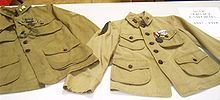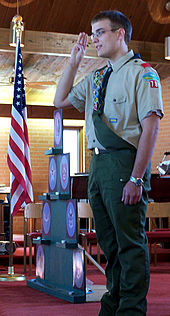- Uniform and insignia of the Boy Scouts of America
-
The uniform and insignia of the Boy Scouts of America (BSA) gives a Scout visibility and creates a level of identity within both the unit and the community. The uniform is used to promote equality while showing individual achievement. While all uniforms are similar in basic design, they do vary in color and detail to identify the different membership divisions of Cub Scouting, Boy Scouting and Venturing. Many people collect BSA insignia such as camporee and jamboree emblems, council shoulder strips and historical badges.
Contents
History
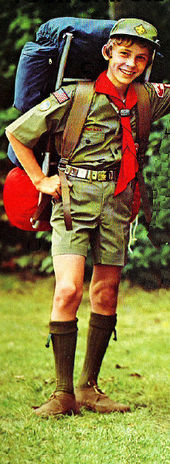 BSA uniform in the 1970s; shirt and shorts of the same color, with an optional baseball-style cap
BSA uniform in the 1970s; shirt and shorts of the same color, with an optional baseball-style cap
Early Boy Scout uniforms were copies of the U.S. Army uniforms of the time. Scouts generally wore knickers with leggings#Military leggings, a button-down choke-collar coat and the campaign hat. Adults wore a Norfolk jacket with knickers or trousers. In 1916, Congress banned civilians from wearing uniforms that were similar in appearance to those of the armed forces with the exception of the BSA.[1] The uniform was redesigned in 1923—the coat and leggings were dropped and the neckerchief standardized. In the 1930s, shorts replaced knickers and their wear was encouraged by the BSA. The garrison (flat) cap was introduced in 1943. In 1965, the uniform's material was changed from wool and cotton to permanent press cloth. The Improved Scouting Program in 1972 included a major overhaul of badges and other insignia, replacing many two color patches with multicolor versions. Also introduced was a red beret and a dark green shirt for "Leadership Corps" members (ages 14–15) in a Scout troop. The Boy Scout uniform during the 1950s–1970s continued to have a monochrome light green color for both shirts and shorts or trousers.
In 1980, a major change was made when a two-color uniform having a tan shirt with olive green shorts or trousers was introduced.[2] Designed by Oscar de la Renta, it continued to be the uniform until August 2008, when the "Centennial Scout Uniform" was unveiled.[2][3] The Oscar de la Renta-designed tan buttoned-front uniform shirt had shoulder epaulets and buttoned-down pocket flaps, worn with an olive green webbed belt with a brass buckle or a tan or brown-leather belt. The olive green cap had a bright red front panel and gold fleur-de-lis. In 2006, olive-green "Switchback" zip-off trousers were introduced in place of the traditional trousers, having an integral belt assembly with provisions for either the olive green webbed or brown-leather belt. Socks were olive green with a red band at the top and came in crew or ankle lengths, or knee length for wear with shorts. Female leaders were provided a choice of slacks, shorts, culottes, or a skirt.
Explorers in the 1950s–1970s had a uniform of spruce green shirt and trousers, but by the 1970s many posts were developing their own uniform. Eventually only the shirt was available, leading many to wear the shirt with olive green Boy Scout pants or shorts. When Exploring was moved to Learning for Life in 1998, the new Venturing division used the spruce green shirt with charcoal gray pants.
The uniform had traditionally been referred to as the "field uniform", but the BSA now uses the terms "official Boy Scout uniform", "official Venturing uniform" and the like. With the introduction of the Switchbacks zip-off pants, the trend is towards a uniform emphasizing comfort and utility.
General
The uniform and insignia are variously protected by copyright, trademark, and congressional charter.[4] The BSA does allow usage for movies and other events, but this is done on a case by case basis. The BSA has rebuked instances where it was felt that the uniform was used inappropriately and without permission.[5] BSA rules and regulations also forbid the use of Scouting emblems for commercial or political purposes. Wear of the uniform and insignia is described in the various handbooks, the Insignia Guide and inspection sheets.[6][7][8][9]
Shirts
Official uniform shirts and blouses are of the button-up style with a pointed collar, two front button-flap pockets, and long or short sleeves. All shirts come with a U.S. flag attached to the right shoulder and a BSA logo strip above the right pocket.
Shoulder loops
The yellow, tan and green shirts have shoulder straps (often referred to as epaulettes). Colored shoulder loops (often called tabs) are worn on the straps to indicate the program level. Cub Scouting adults at the pack level and Webelos Scouts who choose to wear the tan shirt wear navy blue shoulder loops. Boy Scouts and troop-level adults wear forest green shoulder loops; red was replaced by forest green in 2008 and is not worn (see BSA Insignia Guide 2009-2010). Varsity Scouts and team-level adults use blaze (orange) loops. Dark green shoulder loops identify Venturing youth and adults at the crew level. Adults or youth with a district or council position wear silver loops, while those with area, regional or national positions wear gold loops. Blue, red, forest green or blaze loops may not be worn on the green Venturing shirt and dark green loops may not be worn on the tan shirt.[6][10]
Insignia
A wide variety of insignia in the form of cloth patches are worn on the uniform. In general, patches that represent a position of responsibility or an award of merit are referred to as badges and all others are emblems. Other insignia is in the form of medals, ribbons and pins.[6]
Insignia such as merit badge sashes, medals, and pins are generally only worn only on formal occasions such as courts of honor, award banquets, or as part of an honor guard.
Square knot insignia
Medals and the like are not generally worn on the uniform for everyday use; instead, square knot insignia are worn to represent some awards. These insignia are small cloth patches with an embroidered square knot or other emblem that represents the actual award. The colors of the knot, the patch background and the patch border indicates the represented award.
Although they do not use a square knot insignia, the District Award of Merit, the Silver World Award and the Sea Badge award insignia are still referred to as square knots. The Distinguished Commissioner's Award, the District Award of Merit, the Professional Training Award and the series of Cub Scout leader awards do not have a wearable insignia other than the square knot.
The vast majority of Square Knot Insignia can only be earned once, however there are a few (such as the Leader's Training Award, William D. Boyce award, Adult Religious award, Youth Religious award, etc.) that can be earned more than once. Small metal pin-on devices may be worn to show the membership division or the level at which an award was presented if earned more than once. The devices may be used on medals and on the square knot insignia. For example, the Scouter's Training Award may be awarded as the Boy Scout Leader's Training Award, the Varsity Scout Leader's Training Award, the Venturing Leader's Training Award, the Sea Scout Leader's Training Award and the Roundtable Staff Training Award; the appropriate device may be worn to show the division in which the award was earned. Multiple devices may be worn if the award was earned at multiple levels.
Boy Scout and Varsity Scout uniform
The official Boy Scout uniform, known as the Centennial Scout Uniform, is the current uniform of the BSA, named in tribute to the organization's 100th anniversary in 2010.[2] It may be worn by adult leaders, Boy Scouts, and, as an option, by Webelos Scouts. Introduced on August 15, 2008, to have a more outdoors-activity oriented appearance, the Centennial Scout Uniform transitionally replaced the previous version designed by Oscar de la Renta.[2] The BSA declared this uniform "transitional," meaning that those possessing the de la Renta uniform may still wear it and interchange parts with the new uniform, but Council and BSA stores will no longer sell the de la Renta uniform.
The Centennial shirt is a khaki (officially referred by BSA as tan) button-front shirt with collar, bellowed pockets on the chest and left sleeve and closed with hook-and-loop closures, and shoulder epaulets with shoulder loops in the color of the individual's registration (see above). All adults and youth males wear forest green or khaki convertible or Switchback zip-off cargo pants, which easily convert to knee-length cargo shorts with the pull of a zipper. Socks, worn with the uniform, are also forest green and have a black "B.S.A." monogrammed at the top and are available in crew and ankle lengths. The new official belt is a forest green rigger style belt with a black metal mechanical claw buckle – other belt styles, mostly in tan or brown leather, are also worn, while the hat, resembling the U.S. Army's baseball-style fatigue hat worn during the Vietnam War-era, is also in forest green with the B.S.A. emblem embroidered in the front in a ghost stitching.
As with the older Oscar de la Renta-designed uniform of 1980–2008, Boy Scout Troops and Varsity Scout Teams vote to select uniform options for the belt, hat, and neckwear. In place of either the new "Centennial" or older "de la Renta" baseball caps, units may choose to wear various headgear options: the iconic campaign hat (colloquially called the "Smokey Bear" hat, which hearkens back to Scouting's inception in 1907), a scarlet beret, a garrison (flat) cap, or a baseball-style cap of the unit's own design. The beret and garrison cap are now rarely seen as neither hat has been issued for more than 20 years. Neckwear on both uniforms includes the neckerchief and the bolo tie as selected by the unit. A variety of official neckerchiefs are available or the troop can create their own design. Many troops now opt not to wear neckwear. Special neckerchiefs such as Eagle Scout or Wood Badge are generally worn on formal occasions.
Older, all-olive uniforms from the 1970s and earlier may still be worn by Scouters who possess them, although parts may not be worn interchangeably with the current Centennial Scout Uniform or the de la Renta-designed uniforms. They are prized by Scouting memorabilia collectors from around the country.
Cub Scout uniform
The official Cub Scout uniform is worn by youths in Cub Scouting. The basic Cub Scout uniform consists of a navy blue shirt, navy blue pants, shorts or Switchbacks, navy blue socks with gold tops for Cub Scouts or orange tops for Tiger Cubs, a navy blue web belt with brass buckle with Cub Scout logo, a neckerchief with slide, and a navy blue cap with a colored panel. The shirt has buttons, a pointed collar, two front button-flap pockets, and short or long sleeves. The insignia on the cap, neckerchief, neckerchief slide and belt buckle vary by section: Tiger Cubs, Wolf, Bear, and Webelos Scouts.
Cub Scouter uniform for females
Female leaders in the Cub Scouting have the option of wearing the classic yellow blouse with navy blue pants, shorts, skirt or culottes instead of the official Boy Scout uniform.
Venturing uniform
Each Venturing crew votes on the desired uniform; they may use either the official Venturing uniform or may develop their own. Other than emblems, crew developed uniforms may not use elements of other BSA uniforms and must meet other uniform standards, such as not resembling military uniforms. Venturers may not wear the Boy Scout uniform.[6][10]
The official Venturing uniform consists of the spruce green button-up shirt available only in short sleeves, charcoal gray shorts or trousers, gray socks with Venturing logo and the gray web belt with brass buckle and Venturing logo or the black riggers style belt with Venturing logo.
Original hats were the gray baseball cap or the gray bushman hat with snap-up brim, both with Venturing logos. These were replaced by the Venturing ultra-shield uniform cap in gray with a removable fabric shield.
Venturers may develop a unique crew emblem that, with approval from the Scout executive, may be worn on the right sleeve of the uniform.[10][11]
A male Venturer who earned rank as a Boy Scout may wear the rank emblem on the left pocket.
Sea Scouts uniform
Sea Scouts use traditional naval style uniforms sourced directly from the US Navy with buttons and other insignia from BSA Supply. The Sea Scout white cap with logo and the activity shirt are now available for wear. When worn, the male dress blue jumper is worn with the center piping removed from the tar flap collar and cuffs and Sea Scout First Class Anchor bugs sewn-on over the existing 5-point collar stars.
Scouter dress uniform
The Scouter dress uniform is appropriate for professional Scouters and all Scouting leaders on formal occasions. The current version consists of a dark-blue, two-button blazer with white shirt or blouse and heather gray trousers, slacks or a skirt. The blazer's gold-plated buttons bear the universal emblem and an embroidered Cub Scout, Boy Scout or Venturing emblem is worn on the left pocket or lapel. A black leather belt with gold buckle is to be worn with trousers or slacks. Silk neckties with red, gold, and navy stripes are available for men and women. Black dress shoes and black socks or stockings are worn with the dress uniform.
Wood Badge
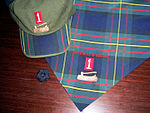
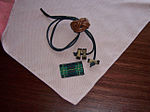
Wood Badge training hat and neckerchief Wood Badge beads, neckerchief and woggle During the Wood Badge course Scouters, both staff and participants, wear the uniform of their unit and membership division; this is a change from the older custom where the uniform was worn without insignia other than the council shoulder patch and the Troop 1 numeral. The uniform is worn with the Wood Badge training hat, the neckerchief and with a woggle made during the opening sessions of the course. The hat and neckerchief use the Troop 1 numeral to represent the first troop to use the Wood badge program. The axe-in-log is the emblem of Gilwell Park where the first Wood Badge course was held and the Maclaren tartan honors William De Bois Maclaren, who donated the funding to purchase Gilwell Park in 1919. After completing Wood Badge the beads, neckerchief and woggle are presented and worn.
Insignia
Boy Scout and Venturer uniform insignia right sleeve right pocket left pocket left sleeve 








Various insignia are worn by Scouts and Scouters representing unit membership, activities, accomplishments, honors and training.
Left sleeve
The council shoulder patch is an arc-shaped patch worn at the top of the sleeve that identifies the local council. Below this, Scouts at the unit level wear a unit number and units with veteran status may wear a veteran unit bar above the numbers. Lone Cub Scouts and Lone Scouts wear the Lone Scout emblem in place of the unit numeral. On the new (2008) style official shirt, the badge of office is centered on the pocket, but on the older official uniform shirts, the badge of office is centered and touching the bottom of the unit numeral, or centered 4 inches below the shoulder seam. When earned for the current position, the green lettering Trained leader strip is centered at the top of the pocket flap on the new style official shirt, but on the older official uniform shirts, the red lettering Trained leader strip is centered immediately below and touching the badge of office. Qualified commissioners may wear the Commissioner Arrowhead Honor in the bottom-most position. Youth who are serving as a den chief may wear a den chief cord around the left shoulder and under the shoulder strap instead of the emblem. Den chiefs who earn the Den Chief Service Award or Webelos Den Chief Service Award may wear the service award cord in addition to the den chief cord, and may continue to wear it for as long as they are a youth.
Right sleeve
Official uniforms come with the US flag sewn to the top of the sleeve. Wearing the flag is optional—Scouts whose religion, tradition, or personal beliefs prevent them from displaying the flag are not required to do so.[12] Below the flag, Cub Scouts (including Webelos) may wear a den number and Boy Scouts and Webelos Scouts (as an option) may wear a patrol emblem. In the next position, Scouts and Scouters may wear the most recent Quality Unit emblem earned by their unit. District or council level Scouters may wear the most recently earned Quality District or Quality Council patch. Venturers may wear the official Venturing emblem or an approved specialty emblem below the flag. Scouts and Scouters at the area or regional level may wear a region emblem below the flag.
Other items that may be worn on the right sleeve include the Musician badge and National Honor Patrol stars. Boy Scouts and Varsity Scouts wearing a long-sleeve shirt may also wear up to six merit badges in two columns of three near the cuff.
Left pocket
The space on the left pocket is reserved to indicate Scout rank. Rank badges that may be worn by Cub Scouts include Tiger Cub, Bobcat, Wolf, and Bear, accompanied by arrow points earned. Webelos Scouts wear only their current badge of rank (Bobcat, Wolf, Bear, or Webelos) centered on the left pocket. As an option, Webelos Scouts who have not earned the Tiger Cub rank may wear all four diamond-shaped ranks arranged as a diamond on this pocket. Scouts in any membership division who have earned the Arrow of Light badge wear it centered below the pocket. Boy Scouts and Varsity Scouts wear their current rank badge centered on the left pocket. Male Venturers may also wear their current Boy Scout rank badge on the official Venturing uniform shirt to age 18, with those becoming Eagle Scouts being allowed to wear the badge until they reach the age of 21.
Scouts and Scouters may wear up to five pin-on medals that they have earned or have been awarded centered just above the pocket seam; medals are usually only worn on formal occasions. Most medals may also be represented by a square knot insignia.
Square knots are rectangular cloth patches that use a multi-colored knot design to designate certain awards. Some emblems use other designs, such as the trident for Sea Badge and the overhand knot for the District Award of Merit, but they are all referred to as square knots. Some awards are represented by both medals or badges and square knots, others only by square knots and others only by the medal or badge. Only a few square knots may be worn by youth, such as the religious emblem or life-saving awards.
Scouters that have completed the Powder Horn course wear their silver metallic emblem from the left pocket button.
Service stars may be worn above the pocket or top row of square knots. These are star shaped pins with an enameled number representing tenure in each Scouting division. Circular plastic backings represent each membership division; gold is used for Cub Scouting, green is used for Boy Scouting, brown used is for Varsity Scouting, red is used for Venturing and blue indicates adult service. Scouts and leaders with tenure as Tiger Cubs prior to 2000 may wear a service star with an orange backing.[13] Those who served in Exploring prior to 1998 may wear a service star with red backing.
All Scouts and Scouters may wear the round World Crest over the pocket. This emblem is found on the uniform of most other Scouting organizations and represents unity with other Scouts around the world. Beginning with January 1, 2010, the Boy Scout 100th Anniversary ring is worn on the outside of the world crest.
Right pocket
The space on the right pocket is reserved for one temporary insignia, such as patches from summer camps or other activities, which should be centered on the pocket. Members of the Order of the Arrow may wear lodge insignia on the flap of the right pocket.
Official uniforms have a BSA strip immediately above the right pocket. There are several insignia that can be placed above the BSA strip, including interpreter strips indicating foreign languages spoken. Varsity Scouts and Boy Scouts in a Venture patrol may wear the corresponding strip above the interpreter strips. If worn, a name tag may be placed just above the BSA strip and interpreter, Varsity, and Venture strips if worn, or on the flap of the right pocket if no lodge insignia is used. Scouts or Scouters that have participated in a National or World Jamboree may wear the corresponding patch centered between the right pocket and the shoulder seam. Visitors to such events may wear the patch as a temporary insignia.
Female Cub Scout leaders may wear the temporary insignia centered between the BSA strip and the shoulder seam.
Merit badge sash
Boy Scouts and Varsity Scouts may wear the merit badge sash, generally on formal occasions. Merit badges may be worn on the front of the sash and the Varsity Letter with earned pins and bars may be worn on the bottom front corner. Additional merit badges and temporary insignia may be worn on the back of the sash.[14] The sash is worn over the right shoulder and should never be worn folded through the belt,[6] should not be worn at the same time as the Order of the Arrow sash, and should never be worn buttoned under the shoulder loop strap.
Non-uniform insignia
A number of emblems are awarded that are not intended for wear on the uniform. The emblems for aquatics qualifications such as Boardsailing BSA, Kayaking BSA, Mile Swim BSA, Scuba BSA, and Snorkeling BSA are intended for wear on the left side of swimwear, while certification such as BSA Lifeguard and BSA Aquatics Instructor are worn on the right side. Other awards such as the 50-Miler Award, Historic Trails Award, Paul Bunyan Woodsman and the Totin' Chip and Firem'n Chit emblems are intended as equipment decoration such as a backpack or on a blanket.
Spoof insignia
Non-official patches, badges, emblems, shoulder loops and other insignia are readily available from third-party suppliers. These spoofs are parodies of existing emblems. For example, spoof versions of the "Trained" emblem include Over Trained, Potty Trained and Untrainable. Common spoof interpreter strips include English, Klingon, Brooklyneese and Southern Drawl, and spoof epaulets include a red, white and blue one for Eagle Scouts and a tiger paw for Tiger Cubs.
Other terminology
Properly, the uniform is referred to as the official field uniform. An activity or utility uniform generally consists of a Scouting related T-shirt, polo shirt or other shirt, often customized with a unit design. Activity or utility uniforms are worn when the official field uniform is not appropriate for activities or as directed by the unit leaders.
Members sometimes refer to these classifications as class A and class B, respectively. Some units further distinguish a full class A or similar classification, that may include the wear of the merit badge sash, medals and the like. Such terminology is not used in any BSA publications and is officially discouraged, but the terms continue to be used by many members.[15]
See also
References
- ^ : When wearing by persons not on active duty authorized
- ^ a b c d Halkias, Maria (July 7, 2008). "Be prepared for a cooler official Boy Scout uniform". The Dallas Morning News. http://www.dallasnews.com/sharedcontent/dws/fea/lifetravel/stories/070408dnmetscoutsuniforma.3fec9f1.html. Retrieved 2009-03-16.
- ^ Peterson, Robert (2002). "From Doughboy Duds to Oscar de la Renta". Scouting Magazine. Boy Scouts of America. http://www.scoutingmagazine.org/issues/0210/d-wwas.html. Retrieved 2006-01-12.
- ^ : Exclusive right to emblems, badges, marks, and words
- ^ Walton, Mike (2000). "Celebrity Costumes- or Uniforming?". The Badge and Uniform Site. Walton, Mike. Archived from the original on 24 December 2005. http://web.archive.org/web/20051224134027/http://www.mninter.net/~blkeagle/celebs.htm. Retrieved 12 January 2006.
- ^ a b c d e Insignia Guide 2007. Boy Scouts of America. 2007. ISBN 0-8395-3066-8. #33066. http://scouting.org/Media/InsigniaGuide.aspx/. Retrieved 2007-10-30.
- ^ "Tiger Cub, Cub Scout and Webelos Scout Uniform Inspection Sheet" (PDF). Boy Scouts of America. 1997, 2007 revision. #34282B. http://scouting.org/filestore/pdf/34282.pdf. Retrieved 2008-02-24.
- ^ "Boy Scout/Varsity Scout Uniform Inspection Sheet" (PDF). Boy Scouts of America. 2007. #34283A. http://scouting.org/filestore/pdf/34283.pdf. Retrieved 2008-02-24.
- ^ "Scout Leader Uniform Inspection Sheet" (PDF). Boy Scouts of America. 2007. #34048. http://scouting.org/filestore/pdf/34048.pdf. Retrieved 2008-02-24.
- ^ a b c Venturer Handbook. Boy Scouts of America. 2005. pp. 6, 93. #33494B. "Male and female Venturers should not wear the BSA tan shirt with dark green (Venturing) shoulder loops."
- ^ Michael R. Brown. (August 11, 2006). "Venturing Uniforming Frequently Asked Questions (FAQ)". U.S. Scouting Service Project. http://usscouts.org/venturing/UniformingFAQ.html. Retrieved 2006-12-03.
- ^ See the 1994 version of the BSA Administration Guide; older manuals for both Cub Scouting and Boy Scouting reference the placement as well but do not give justification
- ^ The Tiger Cub service stars were eliminated when Tiger Cubs were integrated into Cub Scouting in 2000.
- ^ Insignia Guide 2007: Special Regulations. Boy Scouts of America. 2007. ISBN 0-8395-3066-8. #33066. http://www.scouting.org/pubs/33066/03.html. Retrieved 2007-10-30.
- ^ "Saluting in Uniform". Scouting (Boy Scouts of America) (May—June 2006). http://www.scoutingmagazine.org/issues/0605/d-lett.html. Retrieved 2009-03-27.
External links
- "Insignia Images and History". http://eaglescoutbadge.com. Retrieved 2008-11-08.
Boy Scouts of America Organization Advancement and recognition - Boy Scouting and Varsity Scouting awards
- Eagle Scout
- Honors and awards of the Order of the Arrow
- Merit badge
- Ranks in the Boy Scouts of America
- Venturing and Sea Scouting awards
- Quartermaster Award
- Ranger Award
- Silver Award
- Distinguished service awards
- Distinguished Eagle Scout Award
- Silver Beaver Award
- Silver Antelope Award
- Silver Buffalo Award
- Silver World Award
- Other awards
Leadership training and awards - Introduction to Leadership Skills for Troops
- Introduction to Leadership Skills for Crews
- National Advanced Youth Leadership Experience
- National Youth Leadership Training
- National Youth Leadership Training Leadership Academy
- Kodiak
- Powder Horn
- Scouter's Key Award
- Scouter's Training Award
- Seabadge
- Wood Badge
- Youth Protection program
People Events Other Regions and councils - Central Region
- Southern Region
- Western Region
- Northeast Region
- Abraham Lincoln Council
- Alabama-Florida Council
- Alameda Council
- Alamo Area Council
- Alapaha Area Council
- Allegheny Highlands Council
- Allohak Council
- Aloha Council
- Andrew Jackson Council
- Annawon Council
- Anthony Wayne Area Council
- Arbuckle Area Council
- Atlanta Area Council
- Baden-Powell Council
- Baltimore Area Council
- Bay Area Council
- Bay-Lakes Council
- Black Hills Area Council
- Black Swamp Area Council
- Black Warrior Council
- Blackhawk Area Council
- Blue Grass Council
- Blue Mountain Council
- Blue Ridge Council
- Blue Ridge Mountains Council
- Blue Water Council
- Boston Minuteman Council
- Buckeye Council
- Bucks County Council
- Buckskin Council
- Bucktail Council
- Buffalo Trace Council
- Buffalo Trail Council
- Burlington County Council
- Caddo Area Council
- Calcasieu Area Council
- California Inland Empire Council
- Calumet Council
- Cape Cod and the Islands Council
- Cape Fear Council
- Capitol Area Council
- Cascade Pacific Council
- Catalina Council
- Central Florida Council
- Central Georgia Council
- Central Minnesota Council
- Central New Jersey Council
- Central North Carolina Council
- Central Wyoming Council
- Chattahoochee Council
- Chehaw Council
- Cherokee Area Council (Oklahoma)
- Cherokee Area Council (Tennessee)
- Chester County Council
- Chicago Area Council
- Chickasaw Council
- Chief Cornplanter Council
- Chief Okemos Council
- Chief Seattle Council
- Chippewa Valley Council
- Choctaw Area Council
- Cimarron Council
- Circle Ten Council
- Coastal Carolina Council
- Coastal Empire Council
- Colonial Virginia Council
- Columbia-Montour Council
- Concho Valley Council
- Connecticut Rivers Council
- Connecticut Yankee Council
- Conquistador Council
- Cornhusker Council
- Coronado Area Council
- Cradle of Liberty Council
- Crater Lake Council
- Crossroads of America Council
- Dan Beard Council
- Daniel Boone Council
- Daniel Webster Council
- De Soto Area Council
- Del-Mar-Va Council
- Denver Area Council
- Des Plaines Valley Council
- Direct Service
- East Carolina Council
- East Texas Area Council
- Erie Shores Council
- Evangeline Area Council
- Far East Council
- Five Rivers Council
- Flint River Council
- French Creek Council
- Gamehaven Council
- Gateway Area Council
- Georgia-Carolina Council
- Gerald R. Ford Council
- Glacier's Edge Council
- Golden Empire Council
- Golden Spread Council
- Grand Canyon Council
- Grand Columbia Council
- Grand Teton Council
- Great Alaska Council
- Great Lakes Council
- Great Rivers Council
- Great Salt Lake Council
- Great Sauk Trail Council
- Great Smoky Mountain Council
- Great Southwest Council
- Great Trail Council
- Greater Alabama Council
- Greater Cleveland Council
- Greater New York Councils
- Greater Niagara Frontier Council
- Greater Saint Louis Area Council
- Greater Western Reserve Council
- Greater Yosemite Council
- Green Mountain Council
- Greenwich Council
- Gulf Coast Council
- Gulf Ridge Council
- Gulf Stream Council
- Hawk Mountain Council
- Hawkeye Area Council
- Heart of America Council
- Heart of Ohio Council
- Heart of Virginia Council
- Hiawathaland Council
- Hoosier Trails Council
- Housatonic Council
- Hudson Valley Council
- Illowa Council
- Indian Nations Council
- Indian Waters Council
- Inland Northwest Council
- Iroquois Trail Council
- Istrouma Area Council
- Jayhawk Area Council
- Jersey Shore Council
- Juniata Valley Council
- Katahdin Area Council
- Knox Trail Council
- La Salle Council
- Lake Huron Area Council
- Las Vegas Area Council
- Last Frontier Council
- Laurel Highlands Council
- Lewis and Clark Council
- Lincoln Heritage Council
- Lincoln Trails Council
- Long Beach Area Council
- Longhorn Council
- Longhouse Council
- Longs Peak Council
- Los Angeles Area Council
- Los Padres Council
- Louisiana Purchase Council
- Marin Council
- Mason-Dixon Council
- Maui County Council
- Mecklenburg County Council
- Miami Valley Council
- Mid-America Council
- Mid-Iowa Council
- Middle Tennessee Council
- Midnight Sun Council
- Milwaukee County Council
- Minsi Trails Council
- Mississippi Valley Council
- Mobile Area Council
- Mohegan Council
- Monmouth Council
- Montana Council
- Monterey Bay Area Council
- Moraine Trails Council
- Mount Baker Council
- Mount Diablo Silverado Council
- Mountaineer Area Council
- Muskingum Valley Council
- Narragansett Council
- Nashua Valley Council
- National Capital Area Council
- NeTseO Trails Council
- Nevada Area Council
- New Birth of Freedom Council
- North Florida Council
- Northeast Georgia Council
- Northeast Illinois Council
- Northeast Iowa Council
- Northeastern Pennsylvania Council
- Northern Lights Council
- Northern New Jersey Council
- Northern Star Council
- Northwest Georgia Council
- Northwest Suburban Council
- Northwest Texas Council
- Norwela Council
- Occoneechee Council
- Ohio River Valley Council
- Okefenokee Area Council
- Old Colony Council
- Old Hickory Council
- Old North State Council
- Orange County Council
- Ore-Ida Council
- Oregon Trail Council
- Otschodela Council
- Ouachita Area Council
- Overland Trails Council
- Ozark Trails Council
- Pacific Harbors Council
- Pacific Skyline Council
- Palmetto Area Council
- Patriots' Path Council
- Pee Dee Area Council
- Pennsylvania Dutch Council
- Piedmont Council (California)
- Piedmont Council (North Carolina)
- Pikes Peak Council
- Pine Burr Area Council
- Pine Tree Council
- Pony Express Council
- Potawatomi Area Council
- Potomac Council
- Prairielands Council
- Puerto Rico Council
- Pushmataha Area Council
- Quapaw Area Council
- Quivira Council
- Rainbow Council
- Redwood Empire Council
- Revolutionary Trails Council
- Rio Grande Council
- Rip Van Winkle Council
- Rocky Mountain Council
- Sagamore Council
- Sam Houston Area Council
- Samoset Council
- San Diego-Imperial Council
- San Francisco Bay Area Council
- San Gabriel Valley Council
- Santa Clara County Council
- Santa Fe Trail Council
- Scenic Trails Council
- Seneca Waterways Council
- Sequoia Council
- Sequoyah Council
- Shawnee Trails Council
- Shenandoah Area Council
- Simon Kenton Council
- Sioux Council
- Snake River Council
- South Florida Council
- South Plains Council
- South Texas Council
- Southeast Louisiana Council
- Southern New Jersey Council
- Southern Sierra Council
- Southwest Florida Council
- Southwest Michigan Council
- Stonewall Jackson Area Council
- Suffolk County Council
- Susquehanna Council
- Suwannee River Area Council
- Tall Pine Council
- Tecumseh Council
- Texas Trails Council
- Theodore Roosevelt Council
- Three Fires Council
- Three Harbors Council
- Three Rivers Council
- Tidewater Council
- Transatlantic Council
- Trapper Trails Council
- Tri-State Area Council
- Tukabatchee Area Council
- Tuscarora Council
- Twin Rivers Council
- Twin Valley Council
- Utah National Parks Council
- Ventura County Council
- Verdugo Hills Council
- Virgin Islands Council
- Voyageurs Area Council
- W. D. Boyce Council
- West Central Florida Council
- West Tennessee Area Council
- Westark Area Council
- Westchester-Putnam Council
- Western Colorado Council
- Western Los Angeles County Council
- Western Massachusetts Council
- Westmoreland-Fayette Council
- Winnebago Council
- Yankee Clipper Council
- Yocona Area Council
- Yucca Council
 Scouting and Guiding topics
Scouting and Guiding topics 
The Scouting Movement Sections Founders, pioneers, and notable leaders Prominent places International Scouting - Confédération Européenne de Scoutisme
- International Scout and Guide Fellowship
- Order of World Scouts
- Scouts-in-Exile
- International Union of Guides and Scouts of Europe
- World Association of Girl Guides and Girl Scouts
- World Federation of Independent Scouts
- World Organization of the Scout Movement
Other Categories:- Boy Scouts of America
- Scouting uniform
Wikimedia Foundation. 2010.

